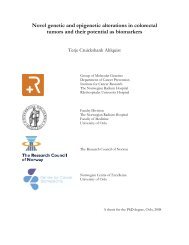Preface - Ous-research.no
Preface - Ous-research.no
Preface - Ous-research.no
You also want an ePaper? Increase the reach of your titles
YUMPU automatically turns print PDFs into web optimized ePapers that Google loves.
Transplantation and Malignancy<br />
In order to get valid effect measures for Ltx for colorectal<br />
cancer the SECA2 study developed. This is a randomized<br />
trial where Ltx is compared to best available oncological<br />
treatment. The study got the approval from the Regional<br />
Ethics Committee, Helse Sor-Ost in December 2010 and it<br />
was initated in January 2011.<br />
The study objectives for SECA2:<br />
••<br />
In a randomized controlled trial to explore whether liver<br />
transplantation in selected patients with liver metastases<br />
from CRC can obtain significant life extension and better<br />
health related quality of life compared to patients receiving<br />
chemotherapy.<br />
••<br />
To explore if patient selection according to <strong>no</strong>mo-grams<br />
for outcome of colorectal cancer can define a subgroup of<br />
patients with a 5 year survival of at least 50% or even cure<br />
from the disease<br />
Primary endpoint<br />
••<br />
Overall survival after randomization<br />
Secondary endpoints<br />
••<br />
Survival related to Memorial Sloan-Kettering <strong>no</strong>mograms<br />
for recurrence after liver resection of metastatic CRC.<br />
••<br />
Disease free survival (RECIST criteria and time to lung<br />
lesions of ≥10 mm)<br />
••<br />
Time to start of new treatment (change in strategy)<br />
••<br />
Quality of life (EORTC QLQ-C30), time to decrease in physical<br />
function and global health score<br />
••<br />
Registration of symptoms (NCI-CTCAE version 4.0)<br />
••<br />
Diag<strong>no</strong>sis of other malignancies<br />
••<br />
Determine <strong>no</strong>mo-gram scores of patients who survive for<br />
5 years or more<br />
••<br />
Survival in relation to biological markers (plasma TIMP-1<br />
and TPA , circulating tumor cells and micro-metastatic<br />
disease in bone marrow biopsies at time of Ltx, different<br />
micro-arrays of liver biopsies, regulatory T-cells, infiltrating<br />
T-lymphocytes in liver biopsies and KRAS and BRAF<br />
mutations.<br />
••<br />
Correlation between recurrence/metastases and other<br />
biological parameters (proteomics, microarray, micro<br />
Based on pilot data from the SECA-study the assumptions<br />
are; 3-year survival of 70% in the Ltx- and 30% in the chemotherapy<br />
group (allocation ratio 1). To detect differences<br />
in survival, sample size is calculated to n=39 patients in each<br />
study arm, based on a two-sided type I error or 5% and a<br />
power of 80%. Accrual period is 30-36 months. A groupsequential<br />
trial analysis with a triangular test designed for<br />
sequential inspection for every sixth deaths and early termination<br />
as soon as results are conclusive will be performed<br />
Project 1. Characterization of the primary tumor, liver<br />
metastases and temporal T-cell immunity in the SECApatients<br />
1.1 Recent studies have addressed the importance of regulatory<br />
T-cells (T regs) in suppressing T-cell immunity to tumor<br />
associated antigens. There is evidence that T regs may<br />
be a main obstacle of successful tumor immu<strong>no</strong>therapy and<br />
that patients who exhibit allograft tolerance have increased<br />
levels of T regs. Temporal levels of T regs are measured at<br />
both preoperatively and at fixed intervals postoperatively.<br />
Lymphoid infiltration in tumors will be assessed, as this has<br />
shown to be an independent prog<strong>no</strong>stic factor in CRC.<br />
1.2 Cytokine profiles will be assessed at Ltx and at defined<br />
time points at follow up. The cytokine profiles will be evaluated<br />
in regard to immu<strong>no</strong>suppressive treatment, to the<br />
cancer disease and in recognition of the liver as an active<br />
immu<strong>no</strong>logical organ participating in local and systemic<br />
host defense. Relevant cytokines will be quantified by<br />
Bioplex assays.<br />
1.3 T-cell immunity will be assessed by mRNA from the tumor<br />
cells at time of Ltx (RNA-later). The RNA will be used to<br />
transfect dendritic cells and mo<strong>no</strong>cytes in order to measure<br />
T-cells ability to recognize this material post transplant.<br />
1.4 T-cell receptor clo<strong>no</strong>type mapping will be performed.<br />
CD4+ and CD8+ T cells will be isolated and used for blocking<br />
experiments. Results will be correlated to the clinical<br />
course of the patients.<br />
1.5 Samples of tissue from the metastases as well as <strong>no</strong>rmal<br />
liver tissue are being collected and frozen (-70ºC) for later<br />
investigations. The properties of this tissue and the possible<br />
relation to the clinical course of the patients will be<br />
explored. The exact modalities of analysis are <strong>no</strong>t yet fully<br />
established as de-freezing is a <strong>no</strong>nreversible event that<br />
needs meticulous planning. The analyses will be performed<br />
after all patients have been included in the trial. There are<br />
several possible paths to follow:<br />
44
















